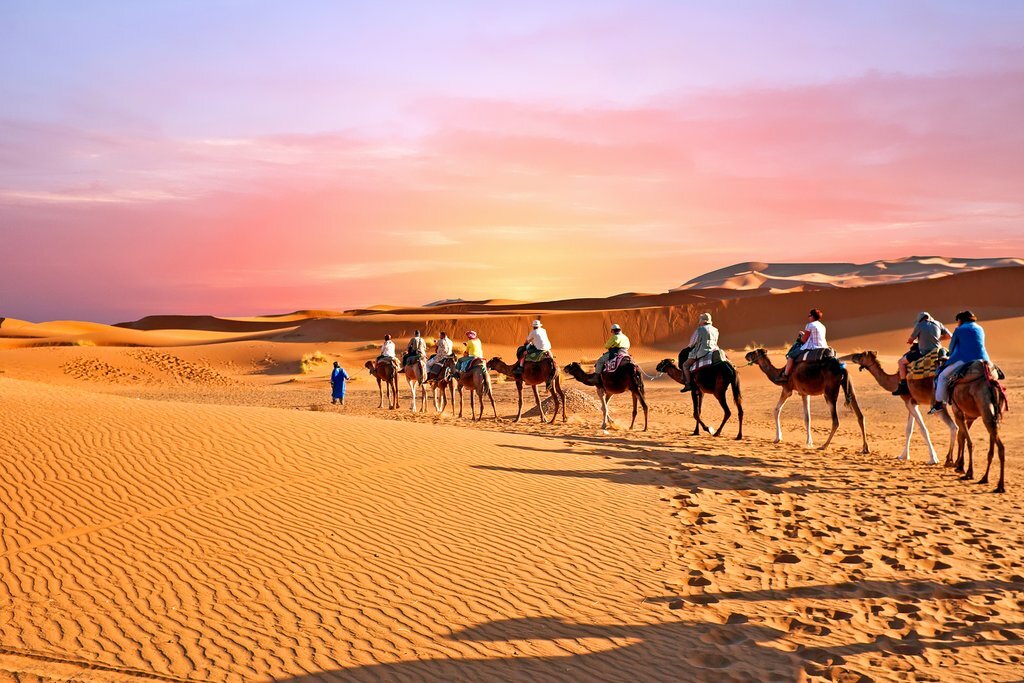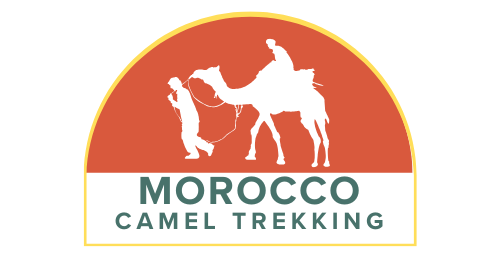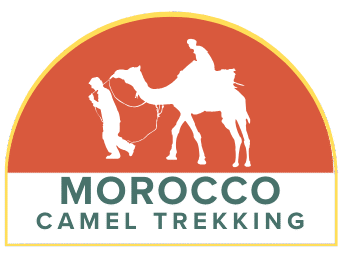Start an unforgettable adventure in the Sahara Desert with camel trekking in Morocco. This unique experience lets travelers see the vast dunes and stunning landscapes of North Africa’s most famous desert.

The Sahara Desert has majestic sand dunes and star-filled skies. It offers an exhilarating journey unlike any other. Our guide will help you plan your trip. You’ll learn how to pick the right tour and when to visit.
Key Takeaways
- Discover the best times to visit Morocco for camel trekking
- Learn how to choose the perfect camel trekking tour
- Understand what to pack for a comfortable desert adventure
- Explore the highlights of the Sahara Desert
- Get tips on preparing for your camel trekking adventure
The Magic of Morocco’s Sahara Desert
The Moroccan Sahara is a land of mesmerizing beauty. It has endless dunes and star-filled skies. This vast desert landscape offers an unparalleled adventure experience, drawing travelers from around the world.

The Unique Landscape of the Moroccan Sahara
The Sahara Desert in Morocco is known for its vast expanses of sand dunes, called ergs. These are some of the most spectacular in the world. The Erg Chebbi and Erg Chigaga dunes are famous, with breathtaking vistas and unforgettable sunsets.
Why Camel Trekking Is the Best Way to Experience It
Camel trekking is an ideal way to explore the Sahara Desert. It allows travelers to immerse themselves in the natural beauty and tranquility of the desert. Riding a camel through the dunes, visitors can experience the rich cultural heritage of the region and enjoy Morocco’s Sahara’s unique landscapes.
What Is Camel Trekking in Morocco?
Camel trekking in Morocco is an adventure unlike any other. It combines culture, history, and stunning landscapes. This traditional way of traveling lets visitors see the Sahara Desert’s vastness, just like traders and travelers have for centuries.
The Authentic Camel Trekking Experience
The real camel trekking experience in Morocco is all about serene desert landscapes and warm Berber hospitality. Treks start in small villages near the Sahara. There, travelers meet their guides and camels.
Historical Significance of Camels in Moroccan Culture
Camels have been key to Moroccan culture for centuries. They were the main way to travel across the desert. Their role goes beyond just getting from one place to another. They symbolize resilience and adaptation in the desert’s harsh conditions.
Types of Treks Available
Camel treks in Morocco cater to different tastes and schedules. The main types are:
Day Trips
Day trips give a glimpse into camel trekking. They usually include a morning desert ride, a picnic lunch, and return in the afternoon.
Multi-Day Adventures
For a deeper dive, multi-day treks offer a chance to spend nights under the stars in desert camps. They let travelers fully experience the Sahara’s tranquility and beauty.
Best Time of Year for Camel Trekking
The best time for camel trekking in Morocco depends on your comfort with heat and crowds. Knowing the seasons helps plan a better trip.
Seasonal Considerations and Temperature Extremes
Morocco’s Sahara Desert has very hot summers and cold winters. Spring (March to May) and autumn (September to November) are the best times. The weather is mild, making trekking more comfortable.
Peak vs. Off-Peak Seasons
The peak season for camel trekking is spring and autumn. The weather is nice, but expect more people and higher costs. Off-peak seasons are quieter but can be colder.
Weather Patterns in the Sahara
The Sahara Desert’s weather is unpredictable. Sandstorms can happen, and it can get cold at night, even in summer. It’s important to be ready for these changes.
- Spring and autumn are ideal for camel trekking due to mild temperatures.
- Peak seasons attract larger crowds and higher prices.
- Off-peak seasons offer a more serene experience but with challenging weather.
Top Destinations for Camel Trekking in Morocco
Camel trekking in Morocco takes you to amazing places. Each spot offers a unique experience. The country’s varied landscapes, from huge dunes to calm oases, are perfect for desert adventures.
Merzouga and the Erg Chebbi Dunes
Merzouga is a top spot for camel trekking, near the Erg Chebbi dunes. The Erg Chebbi dunes offer a surreal landscape ideal for camel rides. The sand dunes stretch far, and treks at sunrise or sunset are magical.
Zagora and the Erg Chigaga
Zagora, in southeastern Morocco, is another camel trekking favorite. It’s the entry to the Erg Chigaga, a less crowded but stunning dune field. Treks here are secluded, letting you enjoy the Sahara’s untouched beauty.
M’hamid El Ghizlane
M’hamid El Ghizlane is a quaint village at the desert’s edge. It’s perfect for camel treks into the deep Sahara. You’ll see Berber villages and desert landscapes, blending culture and adventure.
Comparing the Different Locations
Each spot offers a unique camel trekking adventure. Merzouga is great for those who want tourist-friendly spots. Zagora and M’hamid El Ghizlane are for those seeking less crowded paths. A traveler once said, “The desert is vast and full of surprises and beauty.”
“The Sahara is not just a desert, it’s an experience that stays with you forever.”
Choosing depends on what you want to see, how crowded you like it, and the adventure you seek.
Planning Your Camel Trek
Planning your camel trek in Morocco needs careful thought to enjoy your desert adventure fully. With many tour operators to choose from, knowing what to look for is key for a great trip.
How to Choose a Reputable Tour Operator
Finding a good tour operator is vital for a great camel trek. Look for ones with positive reviews and a strong safety record. Being part of local tourism groups also shows they’re professional and care about responsible tourism.
Questions to Ask Before Booking
Before you book, ask some important questions. These include:
- What is the itinerary and are there any optional activities?
- What is the maximum group size to ensure a personalized experience?
- Are guides experienced and knowledgeable about the area?
- What safety measures are in place?
For more info, check the FAQs page of a trusted tour operator. It answers common questions.
Typical Costs and What’s Included
The cost of camel trekking in Morocco varies. It depends on the trek’s length, luxury level, and what’s included. Make sure you know what’s in the package to avoid surprises.
Booking in Advance vs. On Arrival
While you can book on arrival, booking in advance is best, mainly during peak season. It helps ensure you get a spot and lets you plan your itinerary better.
Essential Packing List for Desert Adventures
Getting ready for camel trekking in Morocco’s desert is key. The right gear makes your trip comfy and fun.
Clothing Recommendations
Choosing the right clothes is vital for camel trekking. The desert’s climate is extreme, with hot days and cool nights.
Daytime Attire
For the day, pick lightweight, breathable clothes that shield you from the sun. Loose cotton is best.
Nighttime Layers
At night, it gets cold. Bring warm layers like fleeces or light jackets to stay cozy.
Sun Protection Essentials
Keeping safe from the desert sun is critical. Pack sunscreen with high SPF, a wide-brimmed hat, and sunglasses.
Personal Comfort Items
For comfort, take moisturizer for dry air, lip balm with SPF, and any needed meds.
Photography Equipment
To capture the desert’s beauty, bring a camera with a good battery, extra memory cards, and a portable charger.
| Item | Purpose |
|---|---|
| Lightweight clothing | Protection from sun and heat |
| Warm layers | Warmth during cold nights |
| Sunscreen and sunglasses | Sun protection |
| Camera equipment | Capturing memories |
Health and Safety Considerations
When you go on a camel trek in Morocco’s Sahara Desert, safety is a top priority. Camel trekking is hard work. Being ready makes your trip safe and fun.
Physical Preparation for Camel Riding
Check your physical health before camel trekking. Camel riding needs balance and stamina. Doing some light exercise a few weeks before helps get you ready.
Common Health Concerns in the Desert
The desert can be tough on your health. You might get dehydrated, sunburned, or exhausted from the heat. Knowing these risks and how to avoid them is key.
| Health Concern | Prevention Measures |
|---|---|
| Dehydration | Drink plenty of water, avoid strenuous activities during peak sun hours |
| Sunburn | Use sunscreen with high SPF, wear protective clothing and a hat |
| Heat Exhaustion | Stay hydrated, take regular breaks in shaded areas |
Staying Hydrated
It’s very important to drink water in the desert. Drink water often during the day.
Emergency Protocols and First Aid
Knowing your tour has emergency plans is comforting. They have first aid kits and ways to call for help.
What to Expect During Your Camel Trek
Embarking on a camel trek in Morocco is an adventure. You’ll ride through the Sahara Desert, seeing amazing sights and learning about local culture.
The Camel Riding Experience
Learning to ride a camel is easy. Guides will help you get on and off.
Mounting and Dismounting Techniques
To get on, stand next to the camel, grab the saddle, and swing your leg over. Hold the reins tight and adjust your seat for comfort.
Comfortable Riding Positions
It’s important to ride comfortably. Sit straight, keep your feet in the stirrups, and hold the reins lightly.
Daily Routines on Multi-Day Treks
On long treks, you’ll follow a daily plan. This includes early morning rides, tea breaks, and camping under the stars. Guides will share stories and insights about the desert and local culture.
Sleeping Arrangements in Desert Camps
Desert camps have simple but cozy accommodations. You’ll sleep under the stars, enjoying the desert’s peace.
Meals and Dining in the Desert
Food is a big part of the trek. You’ll enjoy tasty local dishes, often made by your guides or camp staff. Meals are shared, creating a friendly atmosphere among travelers.
Cultural Etiquette and Interactions
When you start a camel trek in Morocco, knowing the local culture is key. It makes your trip more meaningful. Showing respect for traditions is important.
Respecting Berber and Nomadic Traditions
Morocco has many ethnic groups, like the Berbers. It’s important to respect their ways. A simple act like using your right hand can show a lot of respect.
Communication Tips with Guides and Locals
Good communication is vital for a great camel trek. Learning basic Arabic, like “hello” (Marhaba) and “thank you” (Shukraan), shows you care. For more on places like Erg Chebbi in Merzouga, check out resources on local cultures.
Appropriate Dress and Behavior
Wearing modest clothes is important in Berber and nomadic areas. Dressing right helps avoid misunderstandings. Being open and patient also helps a lot.
By following local customs, you make your camel trek better. You also help keep Morocco’s culture alive.
Capturing the Perfect Desert Photos
The Sahara Desert is a photographer’s dream, with its golden dunes and peaceful views. To get the most out of your camel trek, follow these tips.
Best Times for Desert Photography
The best times for desert photos are early morning and late afternoon. The sun is low, casting a warm, golden light. This light makes the dunes’ textures and colors pop in your photos.
Camera Settings for Sand and Sun
When shooting in the desert, adjust your camera for the bright sun and sand. Use a low ISO, a fast shutter speed, and a polarizing filter to reduce glare. For more on Morocco’s desert landscapes, check out NativeScaravan.
Unique Perspectives and Compositions
Try new angles by getting low or climbing high on dunes. Add depth with camel silhouettes or Berber tents. Experiment with different shots to show the desert’s vast beauty.
Responsible Tourism in the Sahara
The Sahara Desert’s beauty draws many travelers. But, it’s vital to practice responsible tourism. This includes caring for the environment, respecting local communities, and treating camels well.
Environmental Impact of Camel Trekking
Camel trekking can be done in a way that’s kind to the environment. Tour operators who care for the Sahara help keep it beautiful. They make sure to dispose of waste properly and protect special areas.
By picking eco-friendly tours, you can help reduce your impact on the planet.
Supporting Local Communities
Helping local communities is key to making camel trekking sustainable. This means working with local guides, staying in traditional camps, and buying local products. It helps ensure that tourism benefits everyone, building a strong bond between visitors and locals.
Ethical Treatment of Camels
It’s essential to treat camels with kindness and respect. Make sure your tour operator cares for the camels. This means giving them enough rest, loading them safely, and treating them gently.
By choosing tours that value camel welfare, you support ethical practices and enjoy your journey.
For more info on exploring the Sahara Desert, visit Native Scavan for a detailed guide.
Conclusion: Embracing the Desert Experience
Camel trekking in Morocco is a unique adventure that mixes excitement, culture, and stunning views. This guide has shown you the Sahara Desert’s beauty. It’s the perfect place for an unforgettable trip.
The Sahara Desert in Morocco has amazing landscapes like Erg Chebbi and Erg Chigaga. Choosing a good tour operator and respecting the culture and environment makes your trip better. This way, you get a rich and responsible experience.
On your camel trek, you’ll dive into Berber traditions and see stunning sunrises. You’ll also enjoy the desert’s calm. With good planning, you’re set to explore the Sahara’s wonders.
Camel trekking in Morocco is perfect for those who love adventure or peace. It offers memories of the Sahara’s beauty that last a lifetime.
FAQ
What is the best time of year to go camel trekking in Morocco?
The best time for camel trekking in Morocco is spring (March to May) and autumn (September to November). These seasons have mild and comfortable temperatures for travel.
Do I need to be physically fit to go on a camel trek?
Yes, you need a moderate level of physical fitness for camel trekking. You’ll ride a camel for hours and do activities like hiking and exploring villages.
What should I pack for a camel trekking trip in Morocco?
Bring comfortable clothes, sun protection (sunscreen, sunglasses, hat), a first-aid kit, a camera, and a power bank. Choose your clothes based on the season and weather forecast.
How do I choose a reputable tour operator for camel trekking in Morocco?
Look for reviews, certifications, and local tourism board affiliations when choosing a tour operator. Check their guides’ experience, equipment quality, and commitment to sustainability and responsible tourism.
What are the typical costs associated with camel trekking in Morocco?
Costs depend on the trek length, accommodations, and services. Expect to pay $50 to $200 per day for a standard tour. This may include meals, accommodations, and guided tours.
Can I book a camel trek at the last minute, or should I plan ahead?
Booking at the last minute is possible, but planning ahead is better. This ensures availability and makes necessary arrangements, which is important during peak seasons.
Are camel treks suitable for families with children?
Yes, many tours are suitable for families with children. Check with the tour operator about age restrictions and the trek’s suitability for your child. Also, ask about services for families.
What kind of accommodations can I expect during a camel trek?
Accommodations vary from luxury desert camps to basic tented camps. The choice depends on the tour operator and the trek you choose.
How are camels treated during camel trekking tours?
Reputable tour operators treat camels with respect and care. They provide proper food, water, and rest. They follow local guidelines and regulations.
Can I participate in cultural activities or visit local villages during a camel trek?
Yes, many treks include visits to local villages and cultural activities. You can enjoy traditional Berber meals or music performances, enriching your cultural experience.

